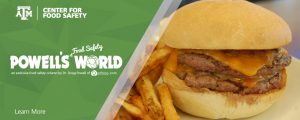Diners who enjoy a juicy burger have been warned that eating them pink in the middle is “like driving without wearing a seatbelt”.
 Fiachradh McDermott of The Irish Times reports that safefood began its new campaign, “Burger Fever”, on Thursday to inform people that eating undercooked burgers could lead to serious or sometimes life-threatening food poisoning.
Fiachradh McDermott of The Irish Times reports that safefood began its new campaign, “Burger Fever”, on Thursday to inform people that eating undercooked burgers could lead to serious or sometimes life-threatening food poisoning.
What she didn’t report is that color is a terrible indicator of safety, and that needle-or-blade-tenderized steaks carry the same risk as mince, so this science-based agency is publishing fairy tales.
But I’ll let the bureaucrats speak for themselves and you judge.
The body advised people to always ask for burgers to be well-cooked in restaurants.
In an online survey conducted by safefood, 96 per cent of people considered themselves well-informed about food safety. However, 51 per cent admitted to eating undercooked burgers.
Two thirds of respondents said they would reconsider their choice if they knew there was a possibility of food poisoning.
Undercooked burgers carry the risk of E. coli, which can have long-term effects. The biggest worry is a type called VTEC, which causes severe diarrhoea.
Dr Linda Gordon, chief specialist in food science at safefood, said it can result in “frequent serious complications.” VTEC can affect the blood and kidneys, and is most serious in older people and children under five. However, it only takes as little as ten E. coli cells to make a person sick, she said.
Dr Gordon said the campaign is intended as a preventative measure, but “emphasising the difference between a burger and a steak” is an important aspect.
According to Dr Gary Kearney, director of food science at safefood, “Mince used in hamburgers is a higher risk as the food poisoning bacteria that live on the surface of the beef (steak) is then mixed through the middle of the burger when the beef is minced – so in effect, the outside is now on the inside.”
 Dr Martin Cormican, Professor of Bacteriology at National University of Ireland, Galway (NUIG), emphasised the possibility and danger of contracting VTEC from undercooked meat.
Dr Martin Cormican, Professor of Bacteriology at National University of Ireland, Galway (NUIG), emphasised the possibility and danger of contracting VTEC from undercooked meat.
“Eating burgers that are pink in the middle is a bit like driving without a seatbelt; you might get away with it for years but if something goes wrong and you are harmed, will you still think it was worth it?”
No mention of thermometer, cooking temps and hold times, just plain pandering.
Use a fucking thermometer and stick it in.
Assessment of risk communication about undercooked hamburgers by restaurant servers
E. Thomas, E,M,, Binder, A., McLaughlin, A., Jaykus, L., Hanson, D, Powell, D.A., Chapman, B. 2016.
Journal of Food Protection Vol. 79, No. 12, pp. 2113-2118
http://www.jfoodprotection.org/doi/abs/10.4315/0362-028X.JFP-16-065?code=fopr-site
According to the U.S. Food and Drug Administration 2013 Model Food Code, it is the duty of a food establishment to disclose and remind consumers of risk when ordering undercooked food such as ground beef.
The purpose of this study was to explore actual risk communication activities of food establishment servers. Secret shoppers visited restaurants (n=265) in seven geographic locations across the U.S., ordered medium rare burgers, and collected and coded risk information from chain and independent restaurant menus and from server responses.
The majority of servers reported an unreliable method of doneness (77%) or other incorrect information (66%) related to burger doneness and safety. These results indicate major gaps in server knowledge and risk communication, and the current risk communication language in the Model Food Code does not sufficiently fill these gaps. Furthermore, should servers even be acting as risk communicators? There are numerous challenges associated with this practice including high turnover rates, limited education, and the high stress environment based on pleasing a customer. If it is determined that servers should be risk communicators, food establishment staff should be adequately equipped with consumer advisory messages that are accurate, audience-appropriate, and delivered in a professional manner so as to help their customers make more informed food safety decisions.
